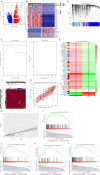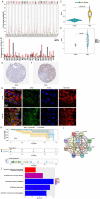The synergistic effect of CDKN2B-AS1 and SPC25 on triple-negative breast cancer
- PMID: 35965791
- PMCID: PMC9372695
- DOI: 10.21037/atm-22-2900
The synergistic effect of CDKN2B-AS1 and SPC25 on triple-negative breast cancer
Abstract
Background: Accumulating evidence suggests that long non-coding ribonucleic acid (RNA) cyclin-dependent kinase inhibitor 2B antisense RNA 1 (CDKN2B-AS1) and messenger RNA (mRNA) spindle component 25 (SPC25) contribute to tumorigenesis and progression in various cancers. However, the synergistic effect between CDKN2B-AS1 and SPC25 has not yet been fully elucidated in triple-negative breast cancer (TNBC). This study sought to examine the synergistic effect of CDKN2B-AS1 and SPC25 and uncover a novel mechanism for the progression of TNBC.
Methods: The transcriptome profiles of TNBC in The Cancer Genome Atlas (TCGA) were calculated for differentially expressed genes (DEGs). Gene co-expression networks were constructed via a weighted correlation network analysis. We validated the relationship between CDKN2B-AS1 and SPC25 by bioinformatics and in-vitro studies (including Cell Counting Kit-8, transwell assays, and quantitative real-time polymerase chain reaction).
Results: CDKN2B-AS1 was found to be carcinogenic and was significantly upregulated and co-expressed with elevated SPC25 expression levels in the TNBC cells and sequencing profiles. Notably, the SPC25 mRNA levels were associated with poor clinical outcomes in TNBC patients. Specifically, the knockdown of CDKN2B-AS1 significantly inhibited TNBC cell proliferation and migration.
Conclusions: We identified a novel cancer-promoting regulation axis. The co-expression of CDKN2B-AS1 and SPC25 is expected to serve as a powerful candidate biomarker for diagnostic and prognostic purposes in TNBC.
Keywords: Triple-negative breast cancer (TNBC); cyclin-dependent kinase inhibitor 2B antisense RNA 1 (CDKN2B-AS1); proliferation; spindle component 25 (SPC25).
2022 Annals of Translational Medicine. All rights reserved.
Conflict of interest statement
Conflicts of Interest: All authors have completed the ICMJE uniform disclosure form (available at https://atm.amegroups.com/article/view/10.21037/atm-22-2900/coif). The authors have no conflicts of interest to declare.
Figures



Similar articles
-
Long non-coding RNA cyclin-dependent kinase inhibitor 2B antisense ribonucleic acid 1 is associated with in-stent restenosis and promotes human carotid artery smooth muscle cell proliferation and migration by sponging miR-143-3p.Exp Ther Med. 2021 Mar;21(3):234. doi: 10.3892/etm.2021.9665. Epub 2021 Jan 21. Exp Ther Med. 2021. PMID: 33603842 Free PMC article.
-
Upregulated lncRNA Cyclin-dependent kinase inhibitor 2B antisense RNA 1 induces the proliferation and migration of colorectal cancer by miR-378b/CAPRIN2 axis.Bioengineered. 2021 Dec;12(1):5476-5490. doi: 10.1080/21655979.2021.1961656. Bioengineered. 2021. PMID: 34511033 Free PMC article.
-
LncRNA CDKN2B-AS1 promotes the progression of ovarian cancer by miR-143-3p/SMAD3 axis and predicts a poor prognosis.Neoplasma. 2020 Jul;67(4):782-793. doi: 10.4149/neo_2020_190617N515. Epub 2020 Apr 16. Neoplasma. 2020. PMID: 32305052
-
CDKN2B-AS1: An Indispensable Long Non-coding RNA in Multiple Diseases.Curr Pharm Des. 2020;26(41):5335-5346. doi: 10.2174/1381612826666200806102424. Curr Pharm Des. 2020. PMID: 32767927
-
The multifaceted functions of SPC25 in cancer: from molecular pathways to targeted therapy.Front Med (Lausanne). 2025 May 7;12:1550901. doi: 10.3389/fmed.2025.1550901. eCollection 2025. Front Med (Lausanne). 2025. PMID: 40400636 Free PMC article. Review.
Cited by
-
Network-based approach elucidates critical genes in BRCA subtypes and chemotherapy response in triple negative breast cancer.iScience. 2024 Apr 16;27(5):109752. doi: 10.1016/j.isci.2024.109752. eCollection 2024 May 17. iScience. 2024. PMID: 38699227 Free PMC article.
-
The Long Non-Coding RNA ANRIL in Cancers.Cancers (Basel). 2023 Aug 17;15(16):4160. doi: 10.3390/cancers15164160. Cancers (Basel). 2023. PMID: 37627188 Free PMC article. Review.
-
The Role of Long Non-Coding RNAs in Modulating the Immune Microenvironment of Triple-Negative Breast Cancer: Mechanistic Insights and Therapeutic Potential.Biomolecules. 2025 Mar 20;15(3):454. doi: 10.3390/biom15030454. Biomolecules. 2025. PMID: 40149989 Free PMC article. Review.
-
SPC25 as a prognostic and immune-related biomarker in lung adenocarcinoma.Sci Rep. 2025 Jul 21;15(1):26414. doi: 10.1038/s41598-025-09615-6. Sci Rep. 2025. PMID: 40691691 Free PMC article.
-
A novel peptide 66CTG stabilizes Myc proto-oncogene protein to promote triple-negative breast cancer growth.Signal Transduct Target Ther. 2025 Jul 9;10(1):217. doi: 10.1038/s41392-025-02298-5. Signal Transduct Target Ther. 2025. PMID: 40628713 Free PMC article.
References
LinkOut - more resources
Full Text Sources
